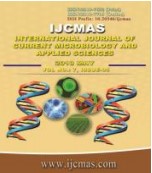


 National Academy of Agricultural Sciences (NAAS)
National Academy of Agricultural Sciences (NAAS)

|
PRINT ISSN : 2319-7692
Online ISSN : 2319-7706 Issues : 12 per year Publisher : Excellent Publishers Email : editorijcmas@gmail.com / submit@ijcmas.com Editor-in-chief: Dr.M.Prakash Index Copernicus ICV 2018: 95.39 NAAS RATING 2020: 5.38 |
A field experiment was conducted at BCKV, Mohanpur, West Bengal during rabi, 2016-17 to study the effect of different combination of nutrients on quality fibre and seed production of dual purpose flax crop. The experiment was in RBD with eight treatments, replicated thrice. The treatment combinations were, T1= 100% recommended dose of nitrogen (RDN) from organic sources (mustard cake, FYM, vermicompost, bone meal and liquid manures), T2= 125% RDN from organic sources, T3= 75% RDN from organic sources +25% RDN from chemical fertilizer sources (Urea, SSP and MOP), T4= 50% RDN from organic sources +50% RDN from chemical fertilizer sources, T5= 100% RDN from chemical fertilizer sources, T6= 125% RDN from chemical fertilizer sources, T7= 75% RDN from chemical fertilizer sources+25% RDN from organic sources and T8= Control. Highest plant height (147.20 cm) was recorded in T2 though highest basal diameter (0.69 cm) was observed in T6. Seed yield was significantly highest (15.40 q ha-1) in T2, followed by T1 and T3. Similarly highest fibre yield of 19.13 q ha-1 was obtained in T2. However significantly lowest plant height, basal diameter, seed as well as fibre yield were recorded in control plots. Regarding fibre quality, better quality fibre with least fineness (2.97 tex) was recorded in T2 whereas fibre with least strength was found in T7 though it was at par with T2. Inferior quality fibre was obtained in control plots. From the observed data it can be recommended that dual purpose flax with 125% of recommended dose of nitrogen (RDN) from different organic sources produce higher yield of both better quality flax fibre and seed under NAZ of West Bengal.
 |
 |
 |
 |
 |